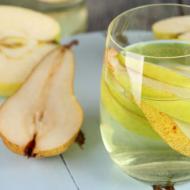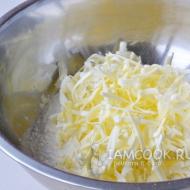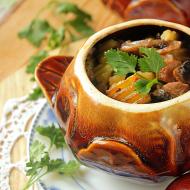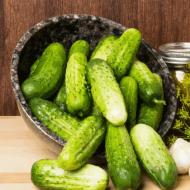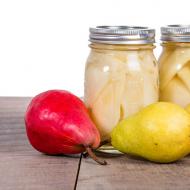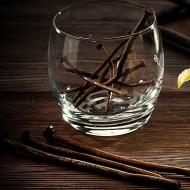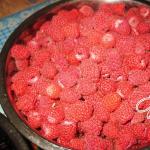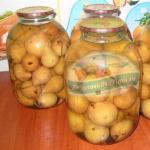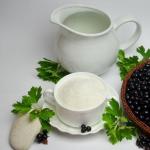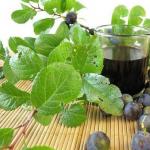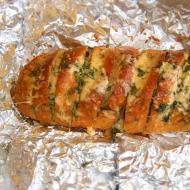
How to pickle cucumbers for the winter in jars
Pickled cucumbers are rightfully considered an integral part of the menu in the winter season. Preservation of vegetables in this way helps to preserve their beneficial properties, due to which the product has a high value. Let's consider the important aspects in order.
- In order for the pickles to turn out to be of high quality, use only young fruits. The so-called “piculi” are considered smaller in size - green cucumbers about 5 cm long. They are followed by gherkins, their length is about 7 cm. Fruits 10-12 cm long will be the best option for pickling. , but they take up a lot of space, and cutting them lengthwise is not supposed to.
- Often you can find canned cucumbers that can be salted together with oak, blackcurrant or cherry leaves. Due to the content of tannins in these plants, cucumbers retain their structure, remaining crisp and dense throughout the entire shelf life.
- If you are focusing on a variety of pickling cucumbers, give preference to Ryabchik, Vyaznikovsky, Dolzhik, Nezhinsky, Borshchagovsky. In cases where a decision is made to preserve vegetables for the future, choose only those fruits that grow in open ground. Greenhouse cucumbers, in turn, are tasteless and watery, they are categorically not suitable for pickling.
- In cases where, after sorting through the fruits, you did not weed out the extra ones (withered, large in size), add granulated sugar to the brine at the rate of 1.5-2% for the entire jar. Such a move must be made in order to speed up the fermentation process, which will not allow the cucumbers to “turn sour”. As a rule, small vegetables (5-10 cm) are salted in a 6-7% solution, while larger fruits are preserved in an 8-9% solution.
- Since cucumbers do not have a pronounced aroma and taste, they must be salted in combination with seasonings and herbs. Such a move will add saturation to the fruits, due to which the latter will not seem insipid. Depending on personal preferences, choose a bouquet of spices yourself, focusing on the taste preferences of household members. The most popular and proven seasonings are coriander, garlic, parsley, allspice (peas), dill, celery, tarragon, horseradish, savory.
- The taste of canned cucumbers is directly dependent on salt. If you use old or stale products, the granules may not dissolve in water. Crystals, in turn, will begin to squeak on the teeth, spoiling the impression of using the product. Cucumbers will be covered with a white coating similar in consistency to mold.

- cucumbers (length 5-7 cm) - 2.3 kg.
- crushed sea salt - 160 gr.
- sugar (preferably beetroot) - 155 gr.
- citric acid - 2 sachets (about 22-25 gr.)
- purified drinking water - 3.2 liters.
- allspice - 8 peas
- garlic - 8 teeth
- horseradish leaves, currant leaves
- parsley dill
- Sort the cucumbers, sort them by size and degree of ripeness, wash thoroughly with a foam sponge. Type cold running water into a large basin, place the fruits there for 3-4 hours. After that, collect ice (preferably melted) water in another container, move the cucumbers into it.
- At this time, start processing the greens. Wash dill, parsley, currant and horseradish leaves to remove all dust and foreign microorganisms. Place the listed ingredients on a towel or paper towel and dry thoroughly.
- Sterilize jars of soda by boiling them in a saucepan for 5-7 minutes. At the end of the period, dry and leave to air at room temperature so that excess moisture evaporates.
- Put the washed greens on the bottom of the sterilized jar, start preparing the brine. Mix sea salt, granulated sugar (both beetroot and cane sugar are allowed), citric acid powder in one loose composition. Pour filtered water into the mixture, put the pot on the stove and bring to a boil.
- When the granules are completely dissolved, turn off the burner, wait 10 minutes, then turn it on again. Boil for another quarter of an hour, then remove from the stove and cool slightly. Put chopped parsley and dill on the bottom of the jar, send currant and oak leaves here. Peel the garlic and cut the cloves into 2 equal parts, send to the container.
- Lay out the cucumbers, arranging them in a convenient way (vertically, horizontally, diagonally), pour the fruits with the resulting brine, let it brew for 10 minutes with the lid open, then roll up and turn the jars upside down. Cover with a towel, cool to room temperature. Take it to the cellar or basement for at least 1 month.

- fresh cucumbers (length about 7-10 cm) - 1.7 kg.
- fresh dill - 1 bunch
- dill (seeds) - 35 gr.
- horseradish root - 4-6 gr.
- wild garlic - 2 stalks
- hot pepper - 3 gr.
- fine food salt - 155 gr.
- purified water - 2 liters.
- Sort the cucumbers by size, shape and variety, wash them under cold water, put them on a towel to dry completely. Pour running water into a bowl, add ice cubes, place the fruits there for 6 hours.
- While soaking is in progress, proceed to sterilize the jars. First, put each of them in a saucepan, pour water and boil. After that, wipe dry, leave until the moisture evaporates. When the soaking time is up, remove the fruit and cut off the “butts”, wash them well with a kitchen sponge to remove bacteria.
- Take an enamel pan, pour salt (food, not sea) into it, add filtered water. Put on the stove, boil so that the granules dissolve completely. After that, pass the pre-chilled brine through 3 layers of gauze.
- Peel the horseradish root, wash and chop the dill. Place cucumbers on the bottom of the jar, alternately shift them with spices (ramson, pepper, horseradish, seeds and a bunch of dill).
- Pour the brine into the container, put the pressing circle and oppression. Take the jar to a warm place for 1 week to start and mark lactic acid fermentation. After the specified period, remove the resulting foam, film and mold, add more brine.
- After updating the composition, take the container to a dark and cold place, the fruits should be thoroughly salted. At the same time, do not forget to remove moldy formations every day and wash the oppression.
- After about 1 week of pickling, remove the cucumbers from the jar, wash them in cold filtered (!) Water. Now place in new (sterile) containers, fill with the brine in which the preliminary preservation was made (first it must be passed through a cotton-gauze filter).
- When all the cucumbers and spices are stacked, close the jars with clean lids. Pour water at room temperature into a wide saucepan, put a jar / jars there, send it to the stove. To prevent the glass container from cracking, it is recommended to put a block of wood or a piece of cloth on the bottom of the pan.
- When the composition begins to boil, note the time, after half an hour, remove the cucumbers from the stove, cork the jars with tin lids. Turn the containers upside down, cool, then take to a cool place for long-term storage.

- short-fruited cucumbers - 1.8 kg.
- fresh dill - 1 bunch
- garlic - 5 teeth
- red pepper (ground) - 2 gr.
- horseradish root - 5 gr.
- blackcurrant (leaves or fruits) - 5/10 gr., respectively
- tarragon (leaves) - 4 gr.
- fine sea salt - 160 gr.
- drinking water - 2.3-2.5 liters.
- Pour sea salt into a thick-walled saucepan, add water, put the container on medium heat and bring the mixture to a boil. When the first bubbles appear, turn down the power, simmer the composition until the crystals are completely dissolved, then remove from the stove and cool. Pass the resulting brine through a gauze fabric folded in several layers, wait 1 hour.
- Sort the cucumbers, leave specimens about 9-10 cm long for conservation. Wash them under the tap, then send them to the basin and soak in ice water (the holding time is about 3-5 hours). After the specified period, wash the fruits again, cut off the “butts”.
- Peel and chop the dill into medium sprigs, cut the garlic cloves into 2 equal parts. Place the spices on the bottom of the container, add red ground pepper, currant berries or leaves, horseradish, tarragon here.
- Lay the cucumbers in a vertical way over the entire cavity of the jar, pour in the saline solution, close the nylon lid. Take the containers to a warm place for 2 weeks, wait for the end of fermentation.
- Remove the film and mold, add the brine to the top, step back from the neck by 3-4 cm. Put the jars in a saucepan, add water, boil for about a quarter of an hour with the lid open. After that, immediately roll up, turn the vessel upside down, cool. Take it to the basement or cellar for 2 months.

- tomatoes - 10 pcs. medium size
- cucumbers - 0.7 kg.
- ground salt - 40 gr.
- granulated sugar - 110 gr.
- horseradish leaves - 5 pcs.
- dill - 0.5 bunch
- parsley - 0.5 bunch
- hot pepper - 1 pod
- garlic - 0.5 heads
- bay leaf - 3 pcs.
- currant leaf - 5 pcs.
- fragrant cloves - 4 stars
- black pepper (peas) - 5 pcs.
- Wash the tomatoes with cold water, wipe them with a kitchen sponge, dry with a towel. Pass through a meat grinder, after removing the peel. Send the resulting porridge to a thick-bottomed pan, put on the stove, simmer (do not boil) over low heat for about half an hour.
- Prepare jars: wash them with soda, then boil for 7 minutes, dry. Soak cucumbers in a bowl of ice, preferably melted water, leave for 5 hours. After this period, cut off the ends, wipe with a towel.
- Wash the dill, parsley, horseradish and currant leaves, peel and chop the garlic into slices. Send the greens to the bottom of a sterile jar, add cloves, peas and hot peppers, bay leaf.
- Mix tomato juice with sugar and salt, wait for the crystals to dissolve completely. Pour the cucumbers with the resulting mixture mixed with boiling water in a ratio of 2: 1. Send the jars to the pan and put on the stove, boil for 10 minutes. Next, screw the containers with a tin lid, cool and transfer for long-term storage.
Like any other business, the preservation of cucumbers has a number of features that must be taken into account without fail. The main rule that you should pay attention to is the correct preparation of the brine, which sets the tone for the whole dish.
Video: a step-by-step recipe for pickled cucumbers for the winter
Related Articles

